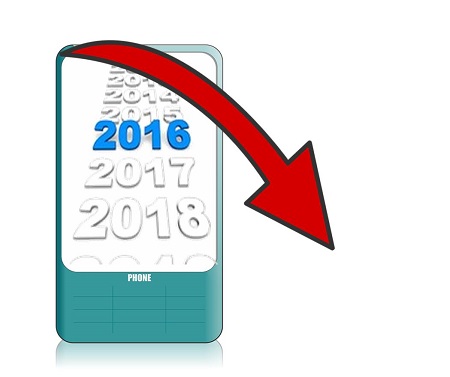Denny |
September 7, 2016
Emerging markets are continuing to exhibit positive growth, but as a whole it is declining in developed regions.
According to the Worldwide Quarterly Mobile Phone Tracker from the International Data Corporation (IDC), smartphone sales are declining as expected. Many forecasts pointed to an overall slowdown of mobile phone sales in 2016. This is linked to a reduction in sales in developed regions.
Despite the positive growth that continues in emerging markets, it isn’t enough to keep the entire marketplace’s pace.
The report showed that much of the smartphone sales currently occurring in developed regions is in replacements. The rate of new users has decreased substantially as penetration within these populations is now very high. The report predicted a 1.6 year over year growth of smartphone shipments in 2016. This, upon the shipment of 1.46 billion units by the end of the year. That may appear to be a healthy number, but it is a fraction of what it was last year. In 2015, the year over year growth rate for smartphone shipments was 10.4 percent.
As a whole, developed markets are expected to see a negative growth rate in smartphone sales.
 The report took the United States, Canada, Western Europe and Japan into its definition of developed markets. Within that region, the IDC predicts a -0.2 percent compound annual growth rate (CAGR). Emerging markets were made up of Central and Eastern Europe, the Asia Pacific Region (except for Japan), Africa, the Middle East and Latin America. They are expected to see a 5.4 percent CAGR throughout the forecast period of 2015 to 2020.
The report took the United States, Canada, Western Europe and Japan into its definition of developed markets. Within that region, the IDC predicts a -0.2 percent compound annual growth rate (CAGR). Emerging markets were made up of Central and Eastern Europe, the Asia Pacific Region (except for Japan), Africa, the Middle East and Latin America. They are expected to see a 5.4 percent CAGR throughout the forecast period of 2015 to 2020.
Senior IDC research analyst at the Worldwide Quarterly Mobile Device Trackers, Jitesh Ubrani, said “Growth in the smartphone market is quickly becoming reliant on replacing existing handsets rather than seeking new users.” Ubrani also stated that from the point of view of the tech side, innovation is “in a lull.” Consumers have greatly reduced their inclination to purchase the latest device with all the newest bells and whistles. Instead, they are satisfied with mobile devices that are “good enough.”
Telcos have been working hard to breathe life back into their smartphone sales. Programs such as trade-ins and buy-backs are geared toward shortening lifecycles and increasing the inclination to purchase early replacements.
The mobile space is driving the evolution of commerce as a whole
It has been 10 years since PayPal launched its first mobile payments service. To celebrate the anniversary of the service, the company has released information to show its exponential growth over its long history. This information is visualized in a chart that was released by PayPal earlier this week. According to PayPal CEO Dan Schulman, the mass adoption of mobile commerce has created a significant shift in the way people spend money. This has begun to change the nature of commerce with consumers relying more heavily on the digital space.
$66 billion in mobile transactions were processed by PayPal in 2015
According to PayPal, one-third of the 4.9 billion payments processed by the company last year were made through mobile devices. This accounts for some $66 billion in mobile transactions. The company believes that the growing prominence of mobile payments services will lead to a change in the commerce space over the next decade. This change may accelerate as more businesses begin supporting mobile transactions and shoppers relying on their smartphones and tablets.
Global mobile payments could reach $4 trillion by 2020
 In the United States, mobile commerce exceeded $100 billion in transactions in 2014. These transactions have continued to grow since, with more consumers becoming comfortable with the prospect of using mobile devices to make purchases. By 2020, mobile transactions could reach more than $4 trillion globally, according to IDC, a market research and analysis firm. With new payment services becoming more secure, more consumers are likely to participate in the mobile commerce space, giving PayPal and other companies new opportunities to expand their mobile initiatives.
In the United States, mobile commerce exceeded $100 billion in transactions in 2014. These transactions have continued to grow since, with more consumers becoming comfortable with the prospect of using mobile devices to make purchases. By 2020, mobile transactions could reach more than $4 trillion globally, according to IDC, a market research and analysis firm. With new payment services becoming more secure, more consumers are likely to participate in the mobile commerce space, giving PayPal and other companies new opportunities to expand their mobile initiatives.
Improved security makes consumers more comfortable with mobile commerce
Consumer adoption of mobile commerce has been heavily influenced by the security and convenience of payment services. Many had consider mobile transactions to be risky as they believed their financial information would be exposed to theft and exploitation. Indeed, some services have been impacted by major data breaches in the past, but these events have served to strengthen security in recent years, making mobile payments more attractive to consumers.
 The report took the United States, Canada, Western Europe and Japan into its definition of developed markets. Within that region, the IDC predicts a -0.2 percent compound annual growth rate (CAGR). Emerging markets were made up of Central and Eastern Europe, the Asia Pacific Region (except for Japan), Africa, the Middle East and Latin America. They are expected to see a 5.4 percent CAGR throughout the forecast period of 2015 to 2020.
The report took the United States, Canada, Western Europe and Japan into its definition of developed markets. Within that region, the IDC predicts a -0.2 percent compound annual growth rate (CAGR). Emerging markets were made up of Central and Eastern Europe, the Asia Pacific Region (except for Japan), Africa, the Middle East and Latin America. They are expected to see a 5.4 percent CAGR throughout the forecast period of 2015 to 2020.
 In the United States, mobile commerce exceeded $100 billion in transactions in 2014. These transactions have continued to grow since, with more consumers becoming comfortable with the prospect of using mobile devices to make purchases. By 2020, mobile transactions could reach more than $4 trillion globally, according to IDC, a market research and analysis firm. With new payment services becoming more secure, more consumers are likely to participate in the mobile commerce space, giving PayPal and other companies new opportunities to expand their mobile initiatives.
In the United States, mobile commerce exceeded $100 billion in transactions in 2014. These transactions have continued to grow since, with more consumers becoming comfortable with the prospect of using mobile devices to make purchases. By 2020, mobile transactions could reach more than $4 trillion globally, according to IDC, a market research and analysis firm. With new payment services becoming more secure, more consumers are likely to participate in the mobile commerce space, giving PayPal and other companies new opportunities to expand their mobile initiatives.